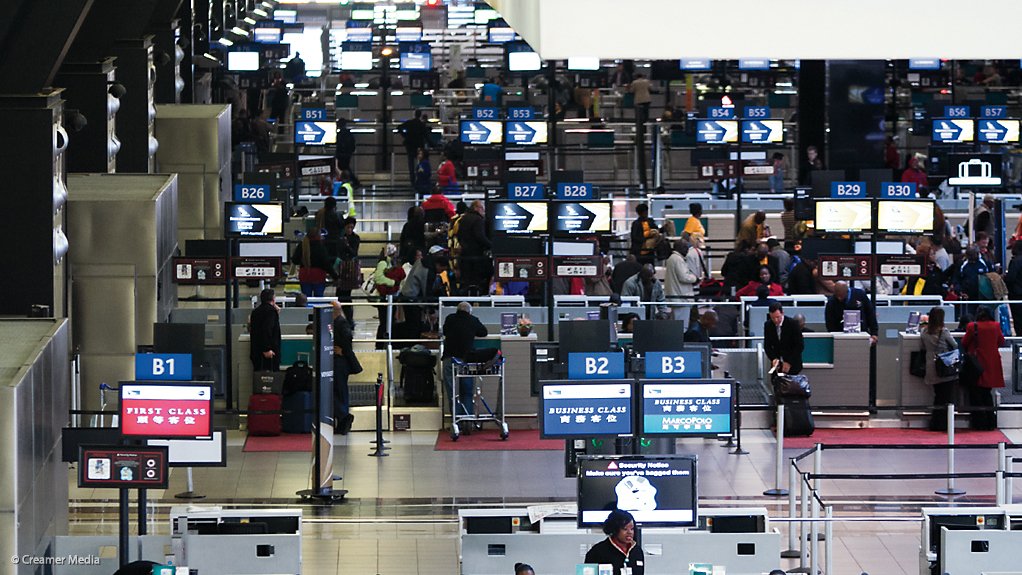Airport development not keeping pace with passenger growth
Globally, airport capacity and airline demand for access to airports have not kept pace with one another, setting global aviation on a path to chaos should mitigation measures not be taken with urgency, according to the International Air Transport Association (Iata).
Passenger load factors are already at all-time highs and, over the next two decades, passengers are expected to double to 7.2-billion, the number of operating aircraft is expected to double, and there should be a 70% growth to 3 000 cargo aircraft. With this in mind, there is not going to be enough airport capacity.
“There is no doubt that we are entering a period where capacity availability is going to impact the ability to serve the demand that is forecast,” said Iata worldwide airport slots head Lara Maughan, addressing media at Iata’s global media day, in Geneva, on Tuesday.
She explained that the number of slot-coordinated airports continued to grow significantly owing to a lack of expansion in airport infrastructure to cope with increasing demand, with the slot process aimed at managing allocation.
“Without a process of allocating capacity available, we will see chaos, with more aircraft than stands available, more passengers than the terminal and its systems can cope with,” she explained.
Currently, 60% of all long-haul flights depart from slot-constrained airports.
Globally, Iata reported that there were 189 Level 3 slot-coordinated airports, and, given the continuing growth in passenger demand and cargo forecasts, it was predicted that another 100 slot-coordinated airports could be declared full within ten years.
“A system or process is needed to allocate what is available in a balanced and controlled manner. A system that should prevent huge congestion developing by only allowing those carriers with slots to operate,” she said, highlighting that administrative allocation through slot coordination was the preferred option when compared with slot auctions and peak and off-peak pricing to mitigate the lack of capacity.
The Iata Worldwide Slot Guidelines is the standard applied at the most capacity-constrained airports worldwide, with an independent and neutral coordinator review undertaken each year.
“This is not the ideal solution, a lack of capacity still remains the critical issue – none of these solve the real problem. Responsible investment in infrastructure needs to be forthcoming, and now,” Maughan commented, adding that no airline wanted to deal with these cumbersome systems when planning their operation or securing growth into new markets, all they want is to serve the demand.
“When we look at the top 100 airports, by passenger volume, we see nearly all airports will need some sort of major infrastructure project within the next decade,” said Iata global airport infrastructure and fuel director Hamant Mistry.
However, with issues such as planning approvals, costs and the complexities of building ever-expanding airports, there is a need to make the best use of technology and advanced processes, and to build the necessary infrastructure around that, added Mistry.
In line with this, Iata launched a new platform, New Experience Travel Technologies (NEXTT), which aims to link different initiatives and maximise value and experience using modern technological developments and advanced processes.
The platform is supported by Airports Council International, along with five airports – Dubai, London Heathrow, Bangalore, Amsterdam Schiphol and Shenzhen, which are using the concepts outlined by NEXTT.
NEXTT identifies three focus areas, namely off-airport activities, in which initiatives outside the airport to facilitate earlier processing and more customisation are delved into; advanced processing, which focuses on the facilitation of simpler, quicker, and more coordinated passenger, cargo and baggage clearance; and interactive real-time decision-making leveraging predictive modelling and artificial intelligence.
These concepts underpin the efficient movement of cargo, baggage and passengers, as well as the turnaround of an aircraft, all delivering efficient operations and modern technologies for smarter and faster movement of cargo, the convenient and hassle-free handling and tracking of baggage for passengers, a seamless, secure and efficient journey for the passenger, and a fully coordinated airport turnaround process using the latest in automation and environment-friendly technologies to increase predictability.
Comments
Announcements
What's On
Subscribe to improve your user experience...
Option 1 (equivalent of R125 a month):
Receive a weekly copy of Creamer Media's Engineering News & Mining Weekly magazine
(print copy for those in South Africa and e-magazine for those outside of South Africa)
Receive daily email newsletters
Access to full search results
Access archive of magazine back copies
Access to Projects in Progress
Access to ONE Research Report of your choice in PDF format
Option 2 (equivalent of R375 a month):
All benefits from Option 1
PLUS
Access to Creamer Media's Research Channel Africa for ALL Research Reports, in PDF format, on various industrial and mining sectors
including Electricity; Water; Energy Transition; Hydrogen; Roads, Rail and Ports; Coal; Gold; Platinum; Battery Metals; etc.
Already a subscriber?
Forgotten your password?
Receive weekly copy of Creamer Media's Engineering News & Mining Weekly magazine (print copy for those in South Africa and e-magazine for those outside of South Africa)
➕
Recieve daily email newsletters
➕
Access to full search results
➕
Access archive of magazine back copies
➕
Access to Projects in Progress
➕
Access to ONE Research Report of your choice in PDF format
RESEARCH CHANNEL AFRICA
R4500 (equivalent of R375 a month)
SUBSCRIBEAll benefits from Option 1
➕
Access to Creamer Media's Research Channel Africa for ALL Research Reports on various industrial and mining sectors, in PDF format, including on:
Electricity
➕
Water
➕
Energy Transition
➕
Hydrogen
➕
Roads, Rail and Ports
➕
Coal
➕
Gold
➕
Platinum
➕
Battery Metals
➕
etc.
Receive all benefits from Option 1 or Option 2 delivered to numerous people at your company
➕
Multiple User names and Passwords for simultaneous log-ins
➕
Intranet integration access to all in your organisation





















